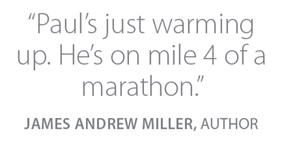After 11 hours of shuttling between sets in a hotel ballroom for ESPN and the SEC Network, interviewing and analyzing coaches and firing the occasional verbal volley at sportswriters for asking inane questions, Paul Finebaum seeks refuge from another day of college football madness by settling in at a restaurant far removed from the Southeastern Conference media days in suburban Birmingham.
But not too far removed. Accompanied by a couple of longtime friends and a reporter for an early dinner at The Bright Star, a James Beard-winning steak and seafood restaurant in Bessemer, Ala., Finebaum and his companions find themselves seated near the kitchen in a private booth.
The Bear Bryant Booth, to be specific. This is the spot where the former Alabama football coach sought occasional refuge, tucked away where he could eat and drink in relative peace. Two tables and four chairs back up to a wall featuring a large, framed photo of Bryant leaning against a goalpost, wearing a red sports coat and his familiar houndstooth hat.
Bryant died in 1983 after winning a then-record 323 college football games, most of them leading the Crimson Tide, including six national championships. Looking up at Bryant’s photo, Finebaum recalled being a young sportswriter in Birmingham when the Alabama coach announced his retirement in December 1982, two weeks before coaching his last game at the Liberty Bowl.
Knowing that Bryant’s career would soon be over made the 26-year-old Finebaum wonder whether his career might be over. Not literally over, but past its peak, since another figure of Bryant’s stature was unlikely to come through Alabama any time soon.
First Look podcast, with Paul Finebaum discussion beginning at the 9:30 mark:
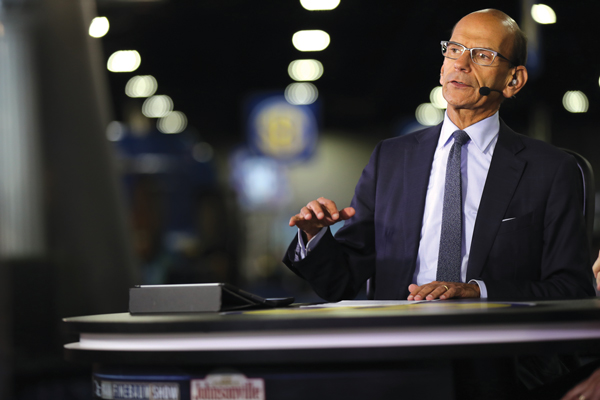 |
The college football insider dreamed big, but often wondered if he’d ever catch a big break.
Courtesy of: ESPN IMAGES |
Finebaum covered the Tide’s victory over Illinois in the coach’s final game on a frigid night in Memphis. A month later, Bryant died. The funeral, like the retirement news and the last game, took on historic proportions. Finebaum believed his biggest stories were already behind him.
“It was eerie,” Finebaum said. “And then Nick Saban came along in 2007.”
In between, Finebaum pondered going to law school, kept writing as a columnist and, beginning in the late 1980s, began a sideline career on sports talk radio. What began as guest stints on a popular morning radio show morphed into a daily talk show and later TV opportunities. By 2011, he dumped writing altogether to concentrate on his radio and TV roles.
Finebaum longed for a national stage, but would anyone give an opportunity to a 50-something reporter based in Birmingham and knee deep in the SEC and Crimson Tide?
■ ■ ■ ■
Even the arrival of Saban, who has led an Alabama renaissance that includes four national titles since 2009, didn’t immediately solve all Finebaum’s challenges to raise his profile.
In the summer of 2012, Finebaum, by now an established sports-talk radio host, found himself in New York City, again believing the best part of his career had passed him by — even with Saban’s powerhouse program boosting interest in his show. Still based in Birmingham at the time, Finebaum had come north seeking advice from an agent on how he could expand his career to a more national audience.
The talent agent, a major player at a firm known for representing sports broadcasting heavyweights, agreed to meet Finebaum as a favor to then-SEC Commissioner Mike Slive.
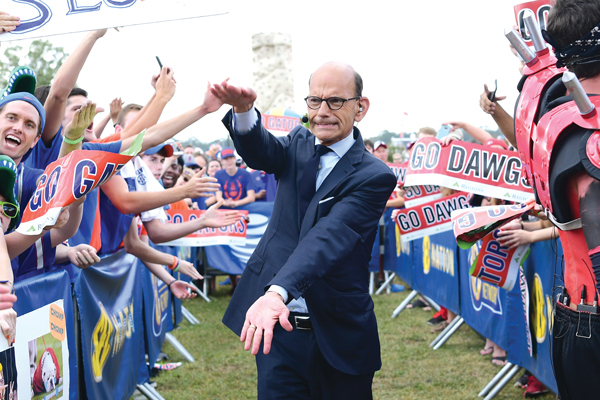 |
Finebaum has established himself as the face of the SEC Network and enjoys interacting with the conference’s passionate fans.
Courtesy of: ESPN IMAGES |
Their discussion lasted all of 15 minutes. Finebaum’s Birmingham-based call-in show had been picked up two years earlier by SiriusXM Radio, broadening his reach. That, Finebaum believed, could be the springboard to bigger things. Instead of having his show carried on satellite radio, maybe SiriusXM would hire him. Or ESPN. Or Fox.
The agent disagreed, telling Finebaum his regional-flavored college football show held little appeal beyond Alabama and the southeast. Finebaum, dejected, walked to Central Park and contemplated the likelihood that he couldn’t go beyond his core Alabama audience. He called his wife while standing, shell-shocked, in New York.
“I’ve had a good career,” Finebaum told his wife, “but there’s nowhere left to go.”
Before leaving New York, Finebaum kept a one-off appointment with a writer who had been blogging about sports for The New Yorker magazine’s website. The blogger’s name: Reeves Wiedeman.
Wiedeman had learned of Finebaum’s raucous radio show, replete with infamous callers berating one another about the Alabama-Auburn rivalry and related football feuds. Wiedeman thought Finebaum’s persona and passionate following offered a unique way to tell the story of college football obsession and especially the obsession with Alabama.
Finebaum slouched into a hotel lobby and introduced himself. He figured a small blog post might result from their conversation, attention that mattered little given the sorry state of Finebaum’s career aspirations.
Wiedeman mentioned shadowing Finebaum for a longer story, an idea, Wiedeman added, that had buy-in from New Yorker editor David Remnick. That got Finebaum’s attention. “I thought, can this day get any more bizarre?”
Six months later, in December 2012, the New Yorker published Wiedeman’s seven-page profile, a month before Saban and the Tide notched their second consecutive national championship by walloping Notre Dame.
The article soon made its way to ESPN executive John Skipper, who, up to that point, had never heard of Finebaum. Several months later, Finebaum signed a five-year contract with ESPN and moved to Charlotte, where his radio show was converted to TV for the startup SEC Network, owned by ESPN.
“Paul has strong opinions and he’ll offer them and he knows when to do it,” Wiedeman said. “But he also smartly knows that what’s interesting is the fans want to hear from each other. … Which is more interesting than just having one person spouting off.”
The New Yorker profile changed the course of Finebaum’s career, which, it turns out, he had, for the second time, erroneously written off. “That game-changed his entire life,” said Richard Deitsch, the media reporter at Sports Illustrated. “It got him to places he never would have gotten to before that. That’s the catalyst where everything now starts from.”
■ ■ ■ ■
Now in his fifth year at ESPN, Finebaum has established himself as the face of the SEC Network — and become a signature voice for ESPN’s college football coverage. He’s a frequent guest on “SportsCenter,” breaking down coaching moves and other developments; appears regularly on the weekday show “College Football Live”; provides analysis on various ESPN shows during College Football Playoff coverage; and is one of the mainstays on “SEC Nation,” the SEC Network’s little-brother version of ESPN’s traveling “College GameDay” pregame show.
More is on the way for the indefatigable Finebaum. Next month, he’s adding weekly “SportsCenter” segments in-studio at the company’s Bristol headquarters. The network will fly Finebaum from his Saturday “SEC Nation” campus pregame show to Connecticut every weekend during the season, giving him a high-profile perch on Sunday morning “SportsCenter” episodes to analyze the college football weekend.
 |
When Finebaum (third from right) posed with Bear Bryant in December 1982, the morning of the legendary coach’s final game, he wondered if his career had already peaked.
Courtesy of: PAUL FINEBAUM |
In addition, his four-hour TV/radio call-in show on SEC Network will be supplemented by an additional hour — starting at 2 p.m. Eastern weekday afternoons — airing exclusively on ESPN2 and emphasizing college football from a national standpoint rather than the SEC-centric version that airs from 3 to 7 p.m.
Stephanie Druley, ESPN senior vice president of events and studio production, said Finebaum’s additional hour, debuting this month, appealed because “just seeing the audience Paul has, we thought it was something that could work. He’ll be able to experiment more in that hour and broaden its appeal.”
This season on “College Football Live,” Finebaum will star in a new segment called “The F-Bomb,” consisting of daily one-minute essays tackling prominent personalities and issues in the sport.
James Andrew Miller, author of the ESPN insider account “Those Guys Have All the Fun,” views Finebaum’s expanding portfolio as inevitable. “He’s got that work ethic and he does his homework,” Miller said. “Paul’s just warming up. He’s on mile 4 of a marathon.”
At 61, Finebaum admits to snapping up assignments almost as soon as they’re offered. His agent, CAA’s Nick Khan, declined to discuss negotiations with ESPN to extend Finebaum’s contract. Deitsch and Miller, among others in the industry, anticipate the two sides will reach an agreement to keep Finebaum at the SEC Network and ESPN well before his contract expires next year.
■ ■ ■ ■
College football media days exist to build hype for a new season. Thus, the bar for news items of interest is painfully low. The slightest hint of genuine emotion from a player or coach gets chewed on for as long as possible to make the most out of what is little more than an off-site corporate retreat.
The SEC media gathering is housed in a sprawling Birmingham hotel connected to a shopping mall. It differs slightly from others only because a few hundred Alabama fans or more are always willing to pack the hotel lobby on the day Saban and a couple of his players arrive for interview sessions. Local TV crews film Saban’s entry each year, chronicling his walk from car to hotel door as though he were a head of state. Which, in a de facto way, he is.
SEC Network airs the various press conferences and provides instant analysis of coaches’ sandbagging about the upcoming season. Most of those coaches also head to nearby sets for SEC Network and ESPN’s “College Football Live” for separate interviews with both networks’ analysts.
Saban and Finebaum generated headlines and social media hot takes a year ago when Finebaum poked Saban for not publicly disciplining two Crimson Tide players arrested in Louisiana during the spring of 2016. Finebaum asked Saban about “a very bad look” for the Alabama football program, prompting the coach to hector Finebaum for unfairly convicting the players in the court of public opinion. During a commercial break that followed the exchange, Saban could be seen and heard yelling at Finebaum before stomping away.
“I thought it was important when he shot back at Saban,” Fox Sports talk-show host Colin Cowherd told SportsBusiness Journal. “Nick can be like all college coaches, a little bit of a bully. When Saban got testy with Paul, the reason he got testy with Paul is because Paul, in [Saban’s] area code, matters. Nick Saban knows that if Paul is cynical on something or questioning something, then so is most of the southern fan base.”
Fast forward to July 2017. During several quick-hit “SportsCenter” exchanges, anchors in the Bristol ESPN studios ask Finebaum, appearing by remote from SEC media days, whether he and Saban will spark more fireworks.
Finebaum laughs.
Soon after, Saban goes to the “College Football Live” set, joining Maria Taylor, Joey Galloway and Booger McFarland. Finebaum, who has come to the same set to appear on a panel with Texas A&M coach Kevin Sumlin, sits down as Saban chats with McFarland during a commercial break. The Alabama coach, who will visit the SEC Network set around the corner in 30 minutes, shakes hands with Finebaum and tells him, “I don’t get to raise hell with you this year?”
Both men laugh. A half-hour later, when Saban heads to the SEC Network stage inside the hotel ballroom, Finebaum is nearby, ready to join a panel that includes analysts Marcus Spears and Greg McIlroy, who both played for Saban. The segment begins. Finebaum prefaces his first question by saying, “Coach, it seems like we were just here when you so rudely interrupted me …”
Saban chuckles. No encore this time.
No matter, though, since Finebaum continues to jab Michigan coach Jim Harbaugh when the urge strikes. (In February, Harbaugh called the ESPN analyst “Pete Finebaum” in a tweet that derided him as an “unabashed SEC water carrier”). Perhaps this factored in to SEC Network’s decision to stage its traveling pregame show Labor Day weekend in Dallas at the Florida-Michigan game (cue Wolverine fans heckling Finebaum).
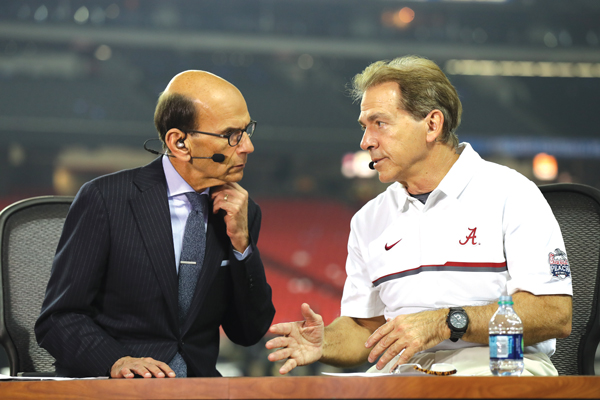 |
On-air sparring with the likes of coach Nick Saban has solidified Finebaum’s reputation.
Courtesy of: ESPN IMAGES |
He nettled Tennessee coach Butch Jones during SEC media days by chiding Jones for not having higher expectations. Jones snapped in a later interview with ESPN — not with Finebaum — that Finebaum had never played football at Tennessee. (True, but Finebaum did graduate from Tennessee, where his provocateur streak at the student newspaper put him at odds with the athletic department, a circumstance that should surprise no one familiar with his later work.)
Such mini-dramas are part of what fuels Finebaum’s following, along with his famed callers. Thanks to raucous exchanges with the host and each other on Finebaum’s show, college football fans have come to know Phyllis from Mulga (Mulga, Ala., that is), Auburn acolyte Tammy, I-Man and Jim from Tuscaloosa.
“It’s fine to get Nick Saban on, it’s fine to get the dudes who run the playoffs, but Finebaum knows what his killer app is,” SI’s Deitsch said. “And his killer app is his callers.”
The most extreme example came in January 2011, two weeks after Auburn won the national championship. A caller identifying himself as Al from Dadeville told Finebaum on-air that he had poisoned two landmark oak trees at Toomer’s Corner as retaliation for Alabama’s loss in the Iron Bowl in 2010. (Al from Dadeville, later identified as Harvey Updyke, is an Alabama fan and pleaded guilty in 2013. He went to jail for several months and was ordered to pay $800,000 in restitution, according to reports.)
■ ■ ■ ■
For Finebaum, all of the appearances, analysis and predictions have almost always gone right, even when controversy follows.
The exception: Last year, first on his SEC Network show and the following day on “College Football Live,” when he categorically dismissed the legitimacy of then-San Francisco 49ers quarterback Colin Kaepernick kneeling during the national anthem in protest of racial inequities and violent confrontations between police and African-Americans.
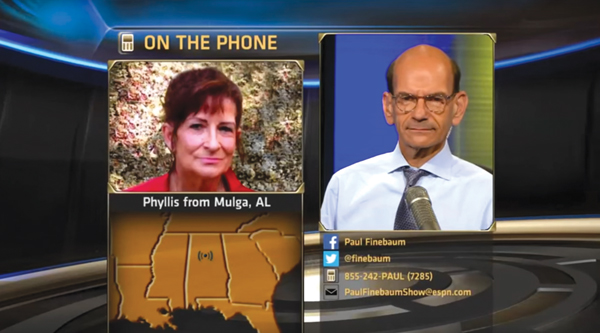 |
Callers such as Phyllis from Mulga (Ala.) provide a colorful take on the college sports scene.
|
“What’s his beef with society other than he’s upset about the way people, in his mind, are being oppressed in this country?” Finebaum asked. Joey Galloway, a retired college star and NFL player who is black, posed a question of his own: “What do you mean, what else? As if that’s nothing.” On his SEC talk show, Finebaum told co-host Marcus Spears, “This country has issues, but it is not oppressing black people.” Finebaum, pilloried on social media, apologized profusely two days later. During an appearance on “SportsCenter,” Finebaum told anchor Cari Champion, who is also black, “I could spend the rest of my life trying to talk my way out of it, but I can’t. I blew it. All I can say is I made a terrible mistake in trying to express a feeling … that I had no right to express.”
Finebaum is grateful his apology was accepted. And his colleagues and co-hosts seem to have no qualms about his sincerity.
SEC cohort Spears often describes Finebaum as like a brother to him. Stephen A. Smith, the ultimate ESPN opinion-maker, told SBJ, “I love being on the air with that man. If you see us, we’re like polar opposites. Our deliveries, our presentations, but he gets it. … It’s a disservice to minimize and pigeonhole him to just SEC football.”
A year later, Finebaum remains vigilant about the balance required to deliver near-constant opinions and interpretations while staying mindful of ESPN’s extensive reach.
Executives who recruited Finebaum to ESPN are, if anything, surprised he went overlooked for so many years.
“It’s probably unique Paul wasn’t discovered earlier, but there is so much about Paul that is unique,” said John Wildhack, a former ESPN executive who is now athletic director at Syracuse University. “While the SEC is always going to be his home field, he’s really become one of the voices of college football.”
Translation: Finebaum’s career is anything but over.
Erik Spanberg writes for the Charlotte Business Journal, an affiliated publication.





